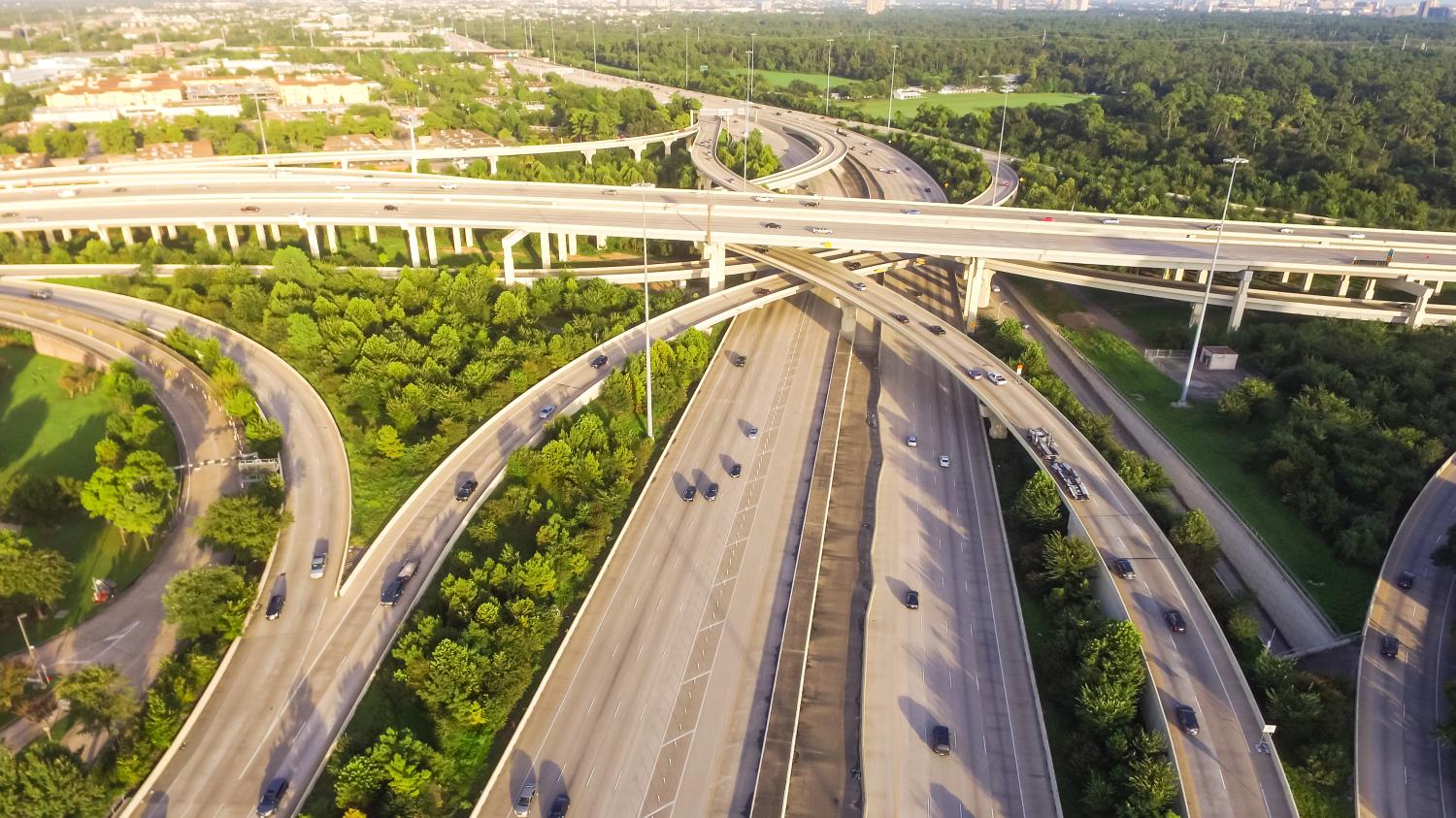With the signing of the Inflation Reduction Act (IRA) this August, congressional lawmakers capped a historically productive year when it comes to transportation policy. Two landmark bills—the Infrastructure Investment and Jobs Act (IIJA) and the IRA—will invest nearly $700 billion in infrastructure, research activities, and related programs that either directly touch the transportation industry or promise to benefit it. Even better, all that federal spending will attract even more commitments from states, localities, and the private sector.
With funding from these laws starting to flow, it makes sense to take stock of where all these federal investments and regulatory reforms leave the transportation sector. The core question: Will the new laws fundamentally transform how people and freight move?
The answer: It’s complicated. Depending on the lens one uses, three pictures emerge:
- If you take a strictly technological view, then yes—the laws are likely to reduce the transportation sector’s end-use emissions via a surge in electric vehicle production and use. The bills commit $119.1 billion to electrify vehicles through manufacturing credits, research into new fuels, and rebates to consumers. The bills should also solidify America’s global competitiveness in vehicle design and manufacturing, leading to greater foreign direct investment and more durable job opportunities.
- If you judge transformation by human behavior, then no—the laws continue to incentivize America’s long-standing driving habits. Across the two laws, $307.2 billion—or 44% of their transportation spending—goes to programs explicitly focused on planning and constructing roadways. When adding other programs that aim to make driving safer, modernize vehicles, and develop new fuel technology, the total rises to $400.7 billion.
- If your focus is community design, then Congress may have planted the seeds for a new national transportation agenda. The IIJA and IRA dramatically increase spending on programs related to multimodal alternatives, new performance measurements, and outcomes related to resilience and environmental justice. These programs are genuine experiments—conducted with state and local partners—to test new approaches to street design, neighborhood connectivity, and how transportation interrelates with other land uses.
In essence, Congress has initiated a critical five- to 10-year period. The full weight of the federal government is behind eliminating much of transportation’s end-use emissions—an essential step in flighting climate change. But legislators also cracked open a policy window for transforming the underlying approach to future federal transportation and land use law. It’s now incumbent on state and local officials to deliver superior results from those policy experiments in order to push Congress to enact the first grand reimagining of federal transportation policy in generations.
Congress is spending big money to transform driving—not replace it
The transportation value chain is extensive. It includes underlying research and design taking place within private companies, research universities, and government offices. The best ideas then get translated into physical production, including mining of raw materials, processing of fuels, and vehicle and component manufacturing. Finally, ideas and equipment help build the physical infrastructure to allow all those manufactured cars, ships, railcars, and airplanes to travel.
The IIJA and IRA are unique because they touch on every step of this value chain—and their spending levels indicate where legislators are making the biggest bets.1
Overall, the IIJA’s spending on infrastructure construction and related capital investments dwarfs all other transportation-related categories: $308.4 billion to roadway and bridge projects, $80 billion to transit agencies, and $66.6 billion to passenger railways, among other modal investments. Critically, most of this funding gives the power to choose capital projects directly to states, transit agencies, and other local authorities.
The IRA prioritized other elements of the transportation value chain.2 The $30.6 billion Advanced Manufacturing Production Credit and the $6.3 billion Advanced Energy Project Credit improve the supply chain for batteries and charging equipment. The $3 billion Advanced Technology Vehicle Manufacturing loans and the $2 billion Domestic Manufacturing Conversion Grants aim to accelerate electric vehicle (EV) manufacturing. And a series of four tax credits valued at $12.5 billion will reduce EV sticker prices for households and companies.

While the IIJA and IRA touch every element of the transportation value chain, the two bills don’t prioritize all transportation modes equally. Instead, the American driver is the big winner.

Across every single programming category but one, IIJA and IRA funding overwhelmingly flows to driving-related programs.3 And in many ways, the approach makes sense. Americans use vehicles for most of their trips, so switching from petroleum to electricity could dramatically reduce greenhouse gas emissions from vehicle use. Trucks also move the vast majority of America’s domestically traded goods, and most of those trips—including all those local e-commerce deliveries—are short enough to leverage current and upcoming battery technology. Still, with 66% of all transportation-related funding going to either electrifying vehicles or modernizing roadways, the bulk of these bills isn’t aiming to get people out of their vehicles.
Instead, the goal is to eliminate fossil fuels from vehicle operations—and it’ll take at least another five years to judge whether those policies worked. Researchers will need to achieve breakthroughs at scale in battery technology and innovative fuel sources such as hydrogen. Manufacturers will have to keep expanding domestic capacity and find approved materials to qualify for consumer- and business-related tax credits. Households and businesses will need to purchase EVs and retrofit their properties with charging infrastructure. Finally, utilities and their partners will need to produce clean electricity, expand transmission capacity, and install new kinds of storage to manage the energy load from all these EVs. America has all the ingredients to drastically reduce end-use emissions from driving, but it will take sustained and complementary actions to achieve it.
Planting the seeds for a new federal approach to state and local transportation
Since the creation of federal highway system in the middle of the 20th century, the American driver has been the primary focus for how the federal government invests in state and local transportation issues. While shifts occurred along the way—like a sustained commitment to mass transit beginning in the 1980s and new metropolitan authorities in the 1990s—the bulk of planning and construction dollars continues to flow to roadway projects.
However, we may look back on the IIJA and IRA as the moment a series of prior smaller steps finally led to a true generational shift. The key ingredient is putting serious programming muscle behind design-focused policy experiments.
The two bills launched 18 new programs—funded with $27 billion—to reconsider how community design and transportation infrastructure impact broader outcomes. Some of these programs focus on climate adaptation, including the PROTECT grants ($8.7 billion) and the Carbon Reduction Program ($6.4 billion). Others focus on how roadway designs can protect human health, including the Safe Streets and Roads for All grant ($5 billion), or aim to promote greater access and proximity between destinations, such as Neighborhood Access and Equity grants ($3 billion).
Legislators also modified many established federal programs to allow federal, state, and local staff to test new concepts. The Biden administration is using federal RAISE grants (formerly known as TIGER and BUILD grants) to primarily fund human-scale projects. The Transportation Alternatives Program, the largest formula program dedicated to non-driving, received significant funding increases and gave metropolitan planning organizations even more spending authority. Many of the largest state-based formula programs also saw their eligibility list expand to permit safety- and resilience-focused projects.
Transportation reformers have waited decades to see Congress commit to this level of policy experimentation. Now, the pressure shifts to state and local officials. First, their jurisdictions need to choose to design and deliver projects that offer a counter to conventional roadway projects: striping more bike and bus lanes, expanding neighborhood tree canopies, protecting infrastructure against extreme weather, running electric school buses, and more. Then, officials need to build an evidence base that shows what differences these projects made in their communities. Congress did their job; now it’s time for their state and local partners to prove Congress can go even bigger next time around.
The next few years could be a national inflection point
The transportation sector stands at a crossroads. Consumers, private industry, and governments at all levels spent nearly a century building a country that overwhelmingly promotes the automobile for both personal and freight-related trips. Now, the weaknesses of that service model are plain to see, including the most greenhouse gas emissions of any domestic economic sector and longer-distance trips than peer countries. We’ve got to change our trajectory.
The IIJA and IRA represent two campaigns to address those weaknesses. The first addresses the immediate need to clean up America’s tailpipe emissions. The second reconsiders how people move within American communities and what kinds of infrastructure projects the federal government should support. Both will run in parallel, but it will take years to know how much sustained progress was made.
If Congress did their work well, we could be on the precipice of a healthier natural environment and an entirely new agenda for designing and building our communities. The stakes couldn’t be higher.
Recommended links for further reading:
- The BlueGreen Alliance offers an excellent rundown of both the clean manufacturing and clean vehicle components of the IRA.
- If you’re a city practitioner and looking to understand how to navigate the IRA more broadly, Columbia Law School’s Climate Law Blog has a great explainer.
- A host of other policy-focused organizations offer rundowns of the IRA and its specific transportation components. The work by the Center for American Progress, Clean Air Task Force, National Resources Defense Council, RMI (broad and trucking-focused), Transportation for America, and the Urban Institute are supportive of the legislation. The American Enterprise Institute and Reason offer more skeptical views.
- For a more global- and energy-centered view on the growing EV marketplace in the U.S., Chetan Hebbale and Johannes Urpelainen published an explainer for Brookings.
-
Footnotes
- While the CHIPS and Science Act will have knock-on effects to the transportation industry—particularly from semiconductor manufacturing—this analysis excludes counting those programs since the benefits do not concentrate enough within the transportation industry.
- This analysis uses the Congressional Budget Office’s 10-year budgetary effects data to estimate total IRA spending levels.
- The IRA’s fuel-focused research and credits also stand to benefit the transit industry. See the American Public Transportation Association’s IRA analysis for more details.




